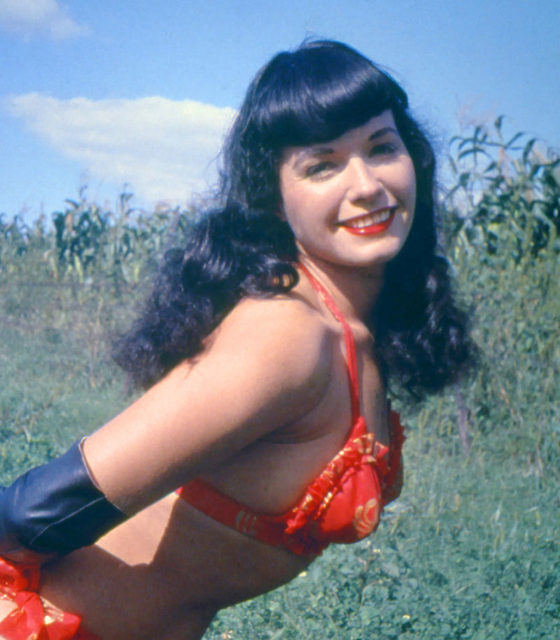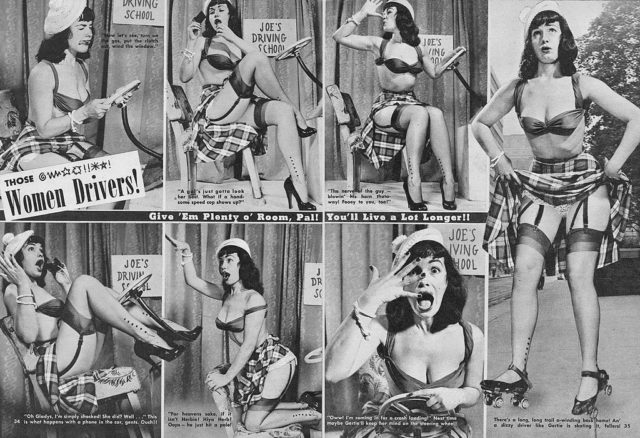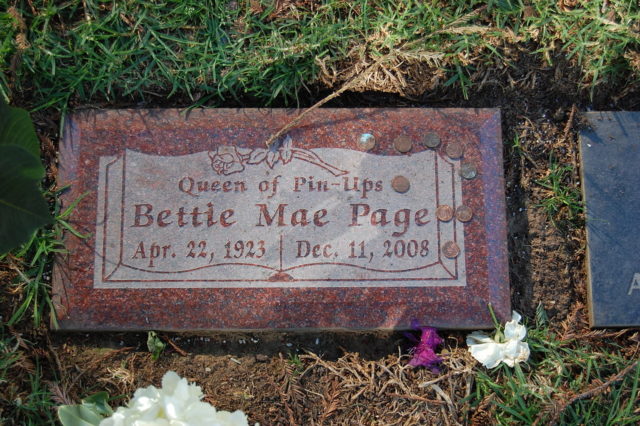In the era of “I Like Ike,” Ozzie and Harriet, and Senator McCarthy, photos of scantily clad women were a furtive business. If the woman in the photos struck a sexually subversive pose, she could end up an underground sensation. Such was the case with Bettie Page, who became a cultural touchstone and major influence more than 20 years after she posed for pinup photographs–and she was one of the last people to know about it.
Before she was Queen of the Pinups, the Dark Angel, and the Queen of Curves, Bettie Page was a Tennessee girl with big dreams. She spent most of her childhood in and around Nashville, one of six children.
Her childhood wasn’t a happy one. The Page family suffered a dysfunctional marriage, and her father was even imprisoned on one occasion after being accused of molesting her. After her parents divorced, she spent a year in an orphanage, an experience she recalled quite vividly in her later years.
In 1941, at the age of 18, Bettie tried her luck in Hollywood but was quickly rejected, supposedly due to her Tennessee accent. According to Greg Theakston, editor and publisher of The Bettie Pages, a fanzine that celebrated pinup culture in the 1980s, part of the reason she never gained success in Hollywood was the fact that she refused to “entertain” the producers after her auditions.

After a short-lived marriage to her high school sweetheart ended in 1947, she moved to New York armed with ambition but pennies in her pocket. Disappointed by Hollywood, she hoped to get her chance on the stage, as the New York theater scene was booming and the bohemian lifestyle was flourishing for the young, ambitious, talented, and most of all, the free-spirited.
After a year of wandering the streets of Big Apple, she was noticed by an African-American police officer, who turned out to be an amateur photographer. He recommended her to a friend, called Cass Carr, who ran a photography club and held classes in photography as part of the YMCA after-school program. This is when she started wearing her black hair cut in a straight fringe bang.
The photographers described her as professional and hard-working. During breaks from posing, she would do typing for secretarial jobs.
Carr would later recall the dedication and the modest attitude of Page: “She was a brilliant typist, and sometimes she would bring in work to do on my typewriter in between posing sessions. I would call her a most controlled young woman, quiet and composed. She didn’t smoke or drink and didn’t much care for those who did.”

She was soon spotted by a number of professional photographers, who found her athletic and voluptuous figure alluring. Together with her jet black hair, the popular fringe, and piercingly blue eyes, she stood out from other models captivating the imagination of men across the country.
Bettie’s look found its way into some popular magazines of the time, like Wink and Flirt, and before she knew it, she was the centerfold of the Christmas edition of Playboy, in 1955.
The crowd called for more. All paths led to one person: Irving Klaw, the so-called Pinup King, who became very interested in Bettie Page, for he saw in her the potential for underground infamy. Klaw had connections that would lead him to develop a certain type of fetish photography for a rich clientele.
Together with his sister Paula, he organized photo shoots with Bettie, bound, wearing high heels, and ironically far more dressed than during her usual sessions. No sexual activity took place, but the sadomasochistic imagery caused her problems later.
Even though many were dying to meet her, Bettie didn’t care too much. In an interview with Rolling Stone in 1989, Paula Irving gave a hint of Bettie’s personal life: “Bettie lived in a very plain little fourth-floor walk-up on 46th Street, with just a bed, a dresser, a TV set, not much else. She usually came to work in a sweater and dungarees. I never saw her dressed up. She really wasn’t aware of her appeal. She laughed at all the fan letters.”

Since she wasn’t exactly a celebrity, Bettie Page apparently saw her role in the pinup world as a sort of a game, or a job to help pay the bills. The Los Angeles Times wrote: “Page was most famous for the estimated 20,000 4-by-5-inch black-and-white glossy photographs taken by amateur shutterbugs from 1949 to 1957. The photos showed her in high heels and bikinis or negligees, bondage apparel–or nothing at all.”
Things changed when a government investigation got the green light to investigate the underworld and possible connections between the porn industry and organized crime.
In the spring of 1955, Estes Kefauver, a Democratic senator, began a large scale investigation of crime syndicates in the United States. His work led to the arrest of one of the most feared mobsters of the time, Frank Costello.
It also looked into Irving Klaw, as a debate ensued concerning the photographs and imagery that revolved around none other than Bettie Page. Bettie felt ostracized and condemned, for even though there was no judicial process against her, those were the times when accusations alone could ruin a person.

She began to retreat from public life. It was not until 1997 that she was officially “discovered” again. During that time, a legend grew around her.
Bettie Page left the world of pinup photography to become a born-again Christian. During the 1960s she made several attempts to become a missionary but was rejected due to her divorce at a young age. She also married twice and divorced both times.
In 1979 she had a nervous breakdown in Southern California after a violent altercation with her landlady, after which she was diagnosed with acute schizophrenia and admitted to the Patton State Hospital in San Bernardino, California. Bettie spent 20 months institutionalized. After release, she got into trouble again and was arrested for assault. She was found not guilty by reasons of insanity, and placed under supervision of the state.

It would seem she hit rock bottom. But in the 1980s and 1990s, Bettie Page’s look–the black hair and bang, the stiletto heels and suggestion of bondage–became very influential, from actresses in The Rocketeer and Pulp Fiction and the George Michael video “Father Figure” to homages from Madonna, Rihanna, and Katie Perry. The Los Angeles Times wrote, “Decades later, those images inspired biographies, comic books, fan clubs, websites, commercial products — Bettie Page playing cards, dress-up magnet sets, action figures, Zippo lighters, shot glasses.”
For much of this time, people weren’t aware that Bettie Page was still alive, and even more remarkably, she didn’t know that she had become a cultural force. Reportedly she didn’t realize her status in Hollywood until she watched a segment of “Entertainment Tonight” while living in a group home outside of L.A. When she realized what had happened, she was stunned, proud, and yet resentful that she had not personally benefited whatsoever. “I’m penniless and infamous,” she told an interviewer. After hiring management, she was able to obtain some income from royalties and licensing.
The Queen of Pinups died of a heart attack in 2008, survived by a brother and a sister.
